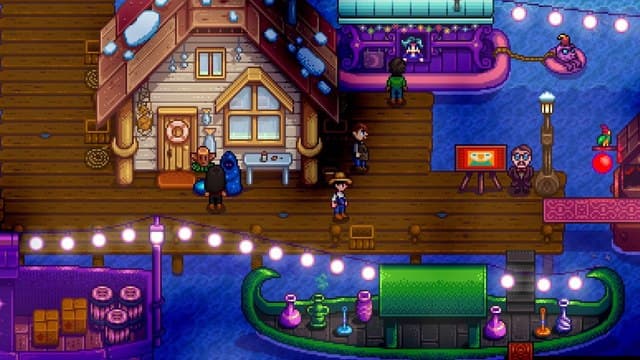For as long as I’ve been playing video games, I’ve loved farming sims and visual novels more than any other genre. Series like Harvest Moon and Story of Seasons are a good mix of the things I enjoy most about gaming: micromanaging resources and romancing the hot neighbor. Like most games, though, they’re made by predominantly male teams. And although inclusivity and diversity in gaming has steadily grown over the years, it’s still common for a game to make me feel like it only tried to meet a severely low bar and immediately stopped there.
As a genderfluid female-identifying Latinx player, it’s already tough for me to find representation of myself in video games, especially when the games are written from the perspectives of cisgender straight men, even when women are the lead characters. This is especially evident in games where players are given the option between male and female avatars, when writers sometimes differentiate between genders in stereotypical ways. It often leaves me feeling like I have to choose a male avatar if I want to experience the story in its purest form. Rune Factory 4 is a game that takes a different approach to its player characters that doesn’t rely on tired stereotypes, making for a very similar experience regardless of which avatar you choose to play as.
More Like This:
- Marketing Representation in Dragalia Lost
- Looking For Better Government in Ni No Kuni 2
- Twenty Four Hours in Fate/Grand Order

A Medieval Farming Fantasy
Rune Factory is a fantasy spin-off of the Harvest Moon series developed by Neverland Co. Much like in Harvest Moon, in each game the player has a farm in a village where they can romance the various townspeople and grow their wealth. The games also include linear stories in which the player typically has to defeat difficult monsters using gear they find during exploration or that they craft themselves from materials.
In Rune Factory 4, you take the role of an amnesiac character who crash lands in the town of Selphia and is adopted as the local prince or princess by the dragon guarding the castle. It has all the trappings of a standard farming sim: you buy seeds to grow crops behind the castle, sell them to make gold, and buy different cooking implements and crafting tables to create dishes, weapons, and clothes to aid you in your quests to help save the guardians of the land. You can romance your local adorable bachelors and bachelorettes, gifting them treats, taking them out on dates, and marrying them.
But what makes Rune Factory 4 stand out from other farming sims I’ve played is what little differentiation the game shows between the male and female avatars in its interactions and dialogue. Aside from who you can and cannot romance, there are few differences when playing as Frey, the female main character, and Lest, the male main character. Frey and Lest have the same bold, passionate personality, and their dialogue reflects that throughout the game. Whatever dialogue Lest has, Frey will echo it word for word. Frey’s dialogue isn’t altered to seem more feminine in contrast to Lest, and the other characters treat her and talk to her the way they speak to Lest, whether they’re simple interactions or flirty exchanges. The few dialogue changes that exist are so rare that they’re difficult to stumble across in the game’s vast word count.
While two characters will refer to your avatar as “Prince” or “Princess” throughout the game, for at least one character you have to explicitly grant them permission to use the title, otherwise they’ll refer to your avatar by their first name. The rest of the villagers will only ever refer to your avatar by their first name, and when playing as Frey, will rarely make any reference to your avatar being female at all. The dialogue is largely ungendered, allowing the player to immerse themselves more fully in the role they’re playing, with the gender of the character being secondary to the personality and actions of the player character. While it’s likely that a tight budget was the driving force behind a lot of these writing decisions, it really says something about how badly female characters are treated in media that a game choosing not to differentiate much between genders has some of the best writing I’ve seen in a long time.

No Escape From Reality
Contrast this with a game like Stardew Valley, a farming sim that soured my entire experience within an hour of playing it. Stardew Valley borrows most of its mechanics and gameplay from games like Rune Factory 4 and Harvest Moon, and seems promising when you first arrive in Pelican Town to begin your adventure. You can dress up your character in male or female clothing and style their hair with masculine and feminine styles, which is something that’s spread to other simulation games like Animal Crossing: Pocket Camp. Having the option of letting your avatar reflect who you are in ways you may not be able to in real life, even if you’re locked into binary pronouns, can feel gratifying. However, that’s more or less where those feelings of gratification end.
Although Stardew Valley allows you to romance any bachelor or bachelorette regardless of the gender of your avatar, if you’re playing with a female avatar the game will grossly never let you forget that through dialogue changes. Some changes seem harmless enough, such as Sebastian confessing that he’s never felt that way about a guy before if you romance him with a male avatar.
But other changes tainted my experience of the game as I made the mistake of playing with a female avatar my first time around. For instance, Alex, a jock-ish love interest, at one point says to the male avatar, “I’d ask you to throw the ball around but you don’t seem like the sports type.” The line is rude and he appears to be a prejudiced jerk, but nothing more. However if you encounter him with a female avatar during this same instance, he says, “If you weren’t a girl, I’d ask you to play catch.”
And suddenly Alex goes from “kind of a jerk” to “sexist asshole” and I’ve lost all will to pursue so much as a friendship with this guy. He does eventually apologize for being rude and arrogant, but that’s only if you manage to power through six full hearts worth of interactions with him, and the game never has him specifically address the sexism in his remark. This isn’t the only instance of a gendered dialogue change, either. Elliott, another bachelor will order a beer for you and himself at the local tavern if you’re playing a male avatar, but will order you a glass of wine if you’re playing with a female avatar. There’s no reason for the game to assume that my character would prefer to drink wine over beer, except girls don’t drink beer, right? That’s what girly, fruity wine is for.
I play games to escape from life and the often harsh realities of being female-presenting in a world that hates women. I’ve had to put up with sexism from men for my entire life, and I’m expected to do it in games. And the thing is, games designed with a message in mind regarding sexism can be culturally important. But Stardew Valley, an otherwise gentle game about revitalizing your soul through farming and connections, didn’t set out to send any such message. These interactions contribute nothing of value to my life, and send the message that as women, we have to power through a man’s sexist behavior because, well, maybe he’s really a sweet guy underneath who needs to learn better. It’s emotional labor I don’t want to do in real life, much less in a video game I paid for.

Hobson’s Choice
In many games where I’m given the option, choosing a female avatar has the chance of altering my entire gaming experience for the worse, simply because the game designers can’t conceive of centering interactions on something other than my gender. Male players can just progress through the story without their gender being pointed out and needled at, making male avatars the better choice by default. Games like Hustle Cat, 2064: Read Only Memories, and Digimon Story: Cybersleuth ensure that players have the same general story experience regardless of whether they choose male or female avatars. Unfortunately like Rune Factory 4, these are smaller, niche games and the exception rather than the rule.
And so I return to Rune Factory 4 over and over again. Regardless of the gender of my avatar, the playing experience is almost identical. This becomes even more obvious when the game gives you the option to change your avatar’s appearance to that of any other NPC character in the game, including the other protagonist. This means that although I might start the game out playing as Frey, I can soon swap my appearance to that of Lest and keep playing as normal, even romancing the male love interests. And with the lack of gendered interactions between my avatar and the love interests, the illusion is very difficult to shatter, making the writing decisions feel even more deliberate.
While Rune Factory 4, like most games, was developed under societal constraints and pressures from its parent studio, it feels like the development team attempted to make the game as comfortable to play for women and even LGBT people as they could under the circumstances. Meanwhile, Stardew Valley, a game created by a one-man crew had literally no one to answer to but its audience, and yet it went out of its way to belittle its female players for the development of its male characters. Rune Factory 4 was the first time I ever played a game where I was an adventuring, monster-slaying farmer first who just happened to be a woman, and I hope that in the future games like Stardew Valley will copy more than just its gameplay mechanics.


